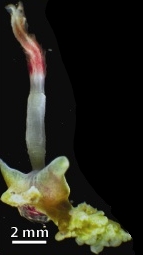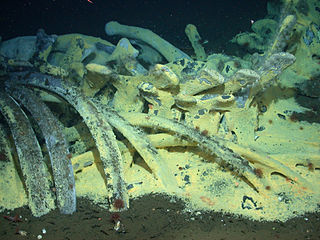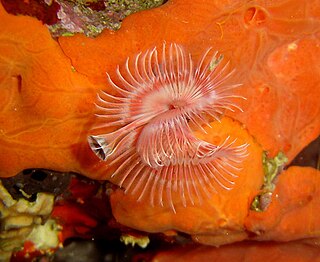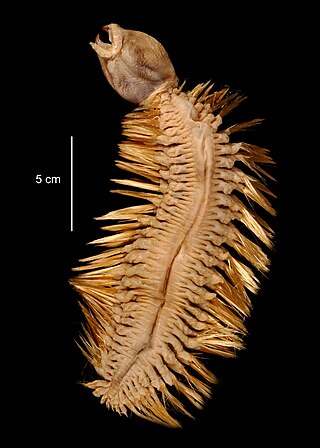
Siboglinidae is a family of polychaete annelid worms whose members made up the former phyla Pogonophora and Vestimentifera. The family is composed of around 100 species of vermiform creatures which live in thin tubes buried in sediment (Pogonophora) or in tubes attached to hard substratum (Vestimentifera) at ocean depths ranging from 100 to 10,000 m. They can also be found in association with hydrothermal vents, methane seeps, sunken plant material, and whale carcasses.

Any worm that lives in a marine environment is considered a water worm. Marine worms are found in several different phyla, including the Platyhelminthes, Nematoda, Annelida, Chaetognatha, Hemichordata, and Phoronida. For a list of marine animals that have been called "sea worms", see sea worm.

Osedax is a genus of deep-sea siboglinid polychaetes, commonly called boneworms, zombie worms, or bone-eating worms. Osedax is Latin for "bone-eater". The name alludes to how the worms bore into the bones of whale carcasses to reach enclosed lipids, on which they rely for sustenance. They utilize specialized root tissues for bone-boring. It is possible that multiple species of Osedax reside in the same bone. Osedax worms are also known to feed on the collagen itself by making holes in the whale's skeletal structure. These holes can also serve as a form of protection from nearby predators.

A whale fall occurs when the carcass of a whale has fallen onto the ocean floor at a depth greater than 1,000 m (3,300 ft), in the bathyal or abyssal zones. On the sea floor, these carcasses can create complex localized ecosystems that supply sustenance to deep-sea organisms for decades. This is unlike in shallower waters, where a whale carcass will be consumed by scavengers over a relatively short period of time. Whale falls were first observed in the late 1970s with the development of deep-sea robotic exploration. Since then, several natural and experimental whale falls have been monitored through the use of observations from submersibles and remotely operated underwater vehicles (ROVs) in order to understand patterns of ecological succession on the deep seafloor.

Polynoidae is a family of marine Polychaete worms known as "scale worms" due to the scale-like elytra on the dorsal surface. Almost 900 species are currently recognised belonging to 9 subfamilies and 167 genera. They are active hunters, but generally dwell in protected environments such as under stones. The group is widely distributed from shallow intertidal waters to hadal trenches. They are the most diverse group of polychaetes in terms of genus number and second most diverse in terms of species number which is almost 8% of all segmented worm species.

Hesionidae are a family of phyllodocid "bristle worms". They are marine organisms. Most are found on the continental shelf; Hesiocaeca methanicola is found on methane ice, where it feeds on bacterial biofilms.

Serpula is a genus of sessile, marine annelid tube worms that belongs to the family Serpulidae. Serpulid worms are very similar to tube worms of the closely related sabellid family, except that the former possess a cartilaginous operculum that occludes the entrance to their protective tube after the animal has withdrawn into it. The most distinctive feature of worms of the genus Serpula is their colorful fan-shaped "crown". The crown, used by these animals for respiration and alimentation, is the structure that is most commonly seen by scuba divers and other casual observers.
Ophryotrocha scutellus, is a species of polychaete worm. Live observation of this species in aquarium experiments indicate a bacterial diet. O. scutellus is named after the Latin scutella for “saucer”, due to its flattened disc-like head. Ophryotrocha scutellus has a dorsoventrally rounded and flattened prostomium, similar to O. platykephale, from which this species differs in jaw morphology, the form of its parapodia and the absence of branchiae.
Ophryotrocha craigsmithi is a species of polychaete worm. O. craigsmithi is named after Craig R. Smith. This species is similar to Palpiphitime lipovskyae and O. Platykephale, among others, in having branchial structures dorsally and ventrally. It differs from O. platykephale in the shape of its prostomium and parapodia. Palpiphitime lipovskyae has jaws of both P- and K-type, while no specimens of O. craigsmithi have been found with K-type jaws thus far. Ophryotrocha craigsmithi differs from P. lipovskyae genetically, but also by the presence of a prominent ventral chaetal lobe with a bulging simple chaeta in the former.
Ophryotrocha eutrophila, is a species of polychaete worm. Ophryotrocha eutrophila is named after its habitat, liking organically enriched environments. This species resembles O. puerilis in jaw morphology. O. eutrophila is dimorphic, with males being than females, while possessing K-type maxillae. Ophryotrocha eutrophila, however, differs from O. puerilis in the absence of eyes and the presence of a developed median pygidial stylus. O. eutrophila is also similar to O. fabriae, differing from the latter from its mandibles morphology.
Ophryotrocha longicollaris is a species of polychaete worm, first found on deep sea whale fall and wood fall habitats in the north-east Pacific, off the southern Californian coast. This species and Ophryotrocha magnadentata are sister species; together with O. nauarchus and O. flabella, it falls in a clade including O. globopalpata and Exallopus jumarsi from the shallow North Atlantic.
Ophryotrocha magnadentata is a species of polychaete worm, first found on deep sea whale fall and wood fall habitats in the north-east Pacific, off the southern Californian coast. This species and Ophryotrocha longicollaris are sister species; together with O. nauarchus and O. flabella, it falls in a clade including O. globopalpata and Exallopus jumarsi from the shallow North Atlantic.
Ophryotrocha nauarchus is a species of polychaete worm, first found on deep sea whale fall and wood fall habitats in the north-east Pacific, off the southern Californian coast. The species is sexually dimorphic, males having appendages on their first chaetiger.
Ophryotrocha flabella is a species of polychaete worm, first found on deep sea whale fall and wood fall habitats in the north-east Pacific, off the southern Californian coast. It is similar to Ophryotrocha globopalpata, possessing some morphological differences, although genetic divergence is low between them.
Ophryotrocha langstrumpae is a species of polychaete worm, first found on deep sea whale fall and wood fall habitats in the north-east Pacific, off the southern Californian coast. It is closely related to Ophryotrocha scutellus and Ophryotrocha batillus.

Terebellides is a genus of polychaete worms in the family Trichobranchidae.

Eulagisca gigantea is a species of scale worm. This species is specifically found in the deep-sea in cold waters like the Antarctic Ocean. The scale worms are named for the elytra on their surface that look like scales

Ophryotrocha is a genus of marine polychaete worms in the family Dorvilleidae.

Eunoe leiotentaculata is a scale worm known from southern Australia and New Zealand and the South Pacific Ocean at depths of 500–1200 m.
Austropolaria is a genus of marine annelids in the family Polynoidae. The genus includes a single species, Austropolaria magnicirrata, which is known only from the Amundsen Sea in the Southern Ocean, at depths of 1000 to 1500m.










